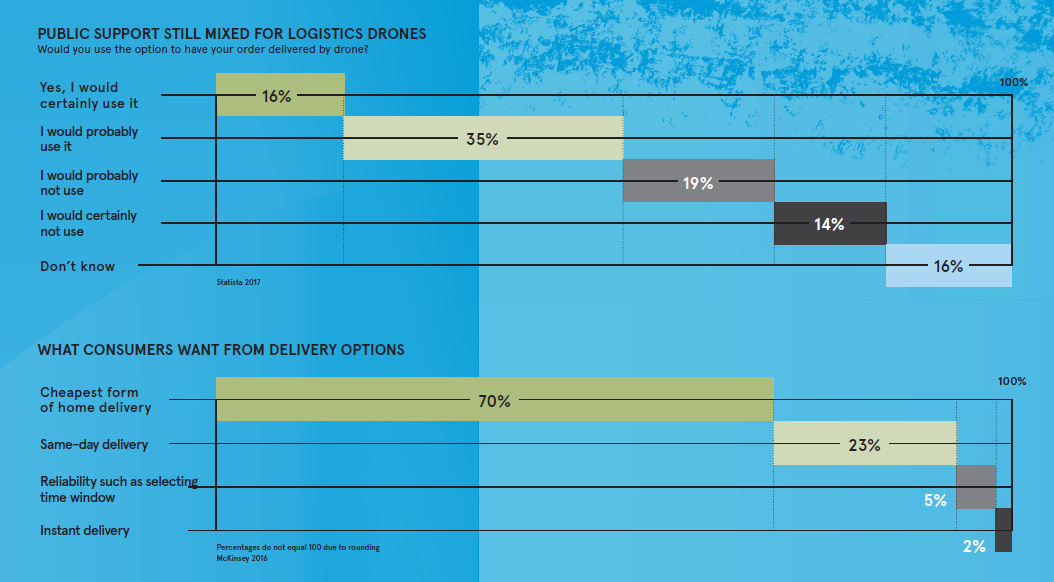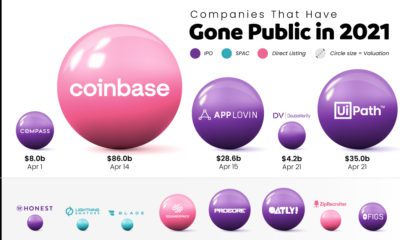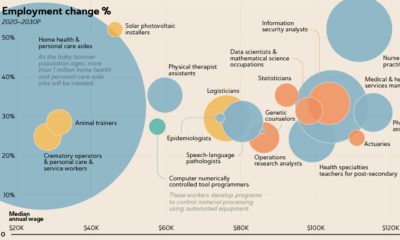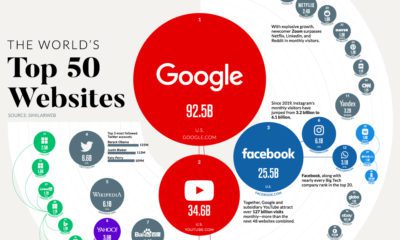Technology
Is the Future of Ecommerce in Drone Deliveries?
View a high resolution version of this graphic
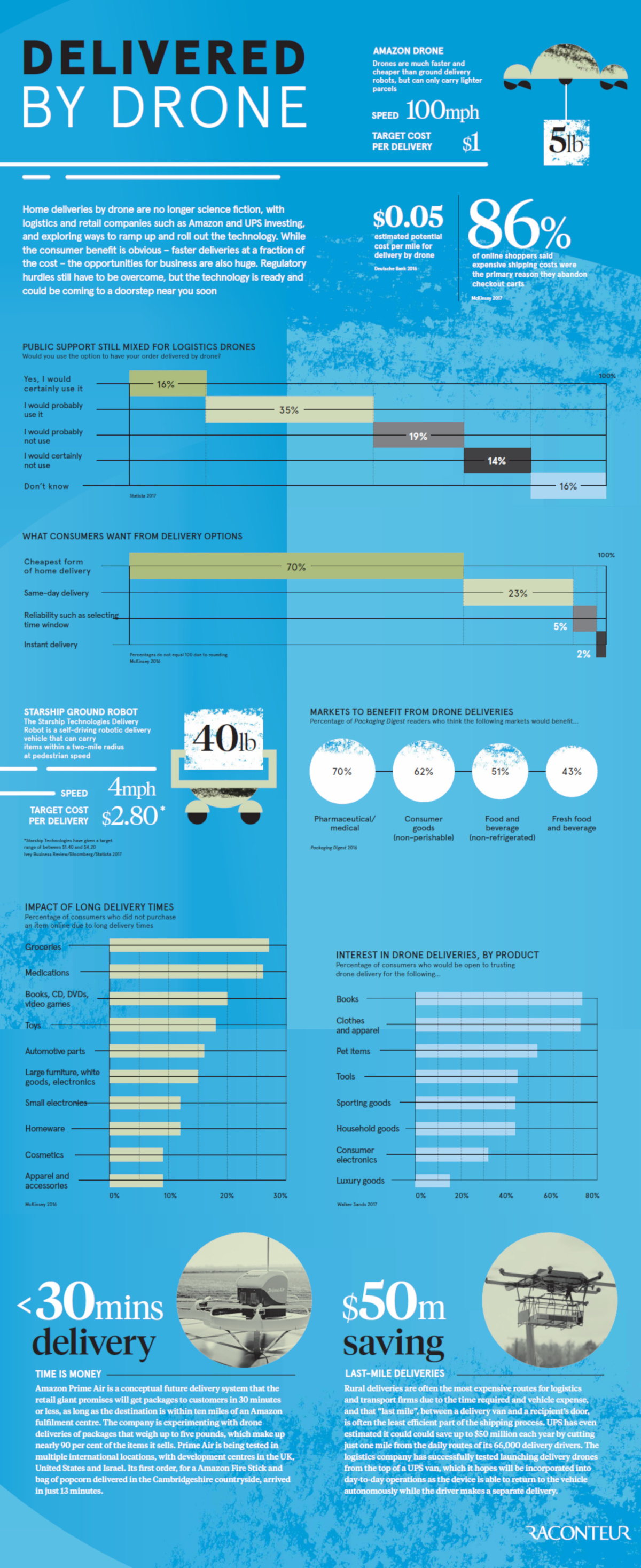
Is the Future of Ecommerce in Drone Deliveries?
View the high resolution version of today’s graphic by clicking here.
In theory, getting a recent purchase delivered in mere minutes is every consumer’s dream.
In practice? It’s not exactly easy to do.
The logistics are complex and intense. The regulatory hurdles are steep and covered with red tape. And like autonomous vehicles, the technology is already capable of the task at hand – however, it will take time to build acceptance and trust with customers to allow drones to fly onto their property for any purpose.
Delivering Benefits
Today’s infographic from Raconteur shows that although the obstacles of drone deliveries may be plentiful, the potential benefits to retailers are too good to pass up.
Amazon, for example, made more than five billion deliveries to Prime customers in 2017, and a conservative estimate of the company’s shipping costs is at the $20 billion mark for last year. That means anything that can hack away at logistical costs would be very welcome for Amazon and other shippers, and drones could be a way to accomplish this.
Commercial drones can travel at up to 100 mph and deliver goods under 5 lbs (2.3 kg) – and according to ARK Investing Group, potentially each trip could occur at a low cost of $1 per shipment.
Even better? Faster shipments could mean higher revenues. After all, 86% of abandoned carts online are the result of expensive shipping costs, according to management consulting group McKinsey & Company.
Investing in Drone Deliveries
Which companies are putting their money into drone deliveries?
There are a few key examples:
Amazon, of course, is the best known one. The online retailer is testing Amazon Prime Air in several international locations to get goods to customers in 30 minutes or less.
UPS has also estimated that cutting off just one mile for the routes of each of the company’s 66,000 delivery drivers would amount to $50 million in savings. For this reason, UPS is testing drone deliveries, using the top of its vans as a mini-helipad.
Domino’s famously delivered the first pizza by drone in 2016 to a New Zealand couple. The pizza company says that drones will be an essential part of its future delivery operations.
Technology
All of the Grants Given by the U.S. CHIPS Act
Intel, TSMC, and more have received billions in subsidies from the U.S. CHIPS Act in 2024.

All of the Grants Given by the U.S. CHIPS Act
This was originally posted on our Voronoi app. Download the app for free on iOS or Android and discover incredible data-driven charts from a variety of trusted sources.
This visualization shows which companies are receiving grants from the U.S. CHIPS Act, as of April 25, 2024. The CHIPS Act is a federal statute signed into law by President Joe Biden that authorizes $280 billion in new funding to boost domestic research and manufacturing of semiconductors.
The grant amounts visualized in this graphic are intended to accelerate the production of semiconductor fabrication plants (fabs) across the United States.
Data and Company Highlights
The figures we used to create this graphic were collected from a variety of public news sources. The Semiconductor Industry Association (SIA) also maintains a tracker for CHIPS Act recipients, though at the time of writing it does not have the latest details for Micron.
| Company | Federal Grant Amount | Anticipated Investment From Company |
|---|---|---|
| 🇺🇸 Intel | $8,500,000,000 | $100,000,000,000 |
| 🇹🇼 TSMC | $6,600,000,000 | $65,000,000,000 |
| 🇰🇷 Samsung | $6,400,000,000 | $45,000,000,000 |
| 🇺🇸 Micron | $6,100,000,000 | $50,000,000,000 |
| 🇺🇸 GlobalFoundries | $1,500,000,000 | $12,000,000,000 |
| 🇺🇸 Microchip | $162,000,000 | N/A |
| 🇬🇧 BAE Systems | $35,000,000 | N/A |
BAE Systems was not included in the graphic due to size limitations
Intel’s Massive Plans
Intel is receiving the largest share of the pie, with $8.5 billion in grants (plus an additional $11 billion in government loans). This grant accounts for 22% of the CHIPS Act’s total subsidies for chip production.
From Intel’s side, the company is expected to invest $100 billion to construct new fabs in Arizona and Ohio, while modernizing and/or expanding existing fabs in Oregon and New Mexico. Intel could also claim another $25 billion in credits through the U.S. Treasury Department’s Investment Tax Credit.
TSMC Expands its U.S. Presence
TSMC, the world’s largest semiconductor foundry company, is receiving a hefty $6.6 billion to construct a new chip plant with three fabs in Arizona. The Taiwanese chipmaker is expected to invest $65 billion into the project.
The plant’s first fab will be up and running in the first half of 2025, leveraging 4 nm (nanometer) technology. According to TrendForce, the other fabs will produce chips on more advanced 3 nm and 2 nm processes.
The Latest Grant Goes to Micron
Micron, the only U.S.-based manufacturer of memory chips, is set to receive $6.1 billion in grants to support its plans of investing $50 billion through 2030. This investment will be used to construct new fabs in Idaho and New York.
-

 Science1 week ago
Science1 week agoVisualizing the Average Lifespans of Mammals
-

 Demographics2 weeks ago
Demographics2 weeks agoThe Smallest Gender Wage Gaps in OECD Countries
-

 United States2 weeks ago
United States2 weeks agoWhere U.S. Inflation Hit the Hardest in March 2024
-

 Green2 weeks ago
Green2 weeks agoTop Countries By Forest Growth Since 2001
-

 United States2 weeks ago
United States2 weeks agoRanked: The Largest U.S. Corporations by Number of Employees
-

 Maps2 weeks ago
Maps2 weeks agoThe Largest Earthquakes in the New York Area (1970-2024)
-

 Green2 weeks ago
Green2 weeks agoRanked: The Countries With the Most Air Pollution in 2023
-

 Green2 weeks ago
Green2 weeks agoRanking the Top 15 Countries by Carbon Tax Revenue

